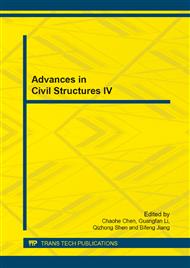p.974
p.981
p.987
p.991
p.995
p.1000
p.1007
p.1012
p.1016
Autoexcitation-Based Accelerometer Array for Interface Separation Detection of Concrete-Filled Steel Tubular Arch Bridge
Abstract:
The separation between the filled-concrete and the steel tube would reduce tremendously the bearing capacity of the concrete-filled steel tubular (CFST) arch bridge. However, there is no efficient method to monitor and detect the separation so far, which is a great engineering problem we have to solve. Therefore, this paper firstly proposes a vibration test method aiming at the local modal of the steel tube. Distributed accelerometer array deployed along the tube is used to acquire the vibration signal induced by quantitative excitation via telecontrol. Changes in frequency and amplitude of the steel tube are selected as parameters for the separation detection based on the theory of surface wave transmission. This method can satisfy the demand of the real-time monitoring of interface separation of the CFST arch bridge.
Info:
Periodical:
Pages:
995-999
Citation:
Online since:
July 2014
Authors:
Price:
Сopyright:
© 2014 Trans Tech Publications Ltd. All Rights Reserved
Share:
Citation:


